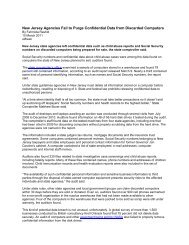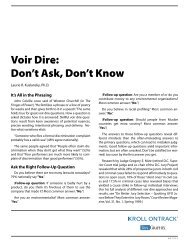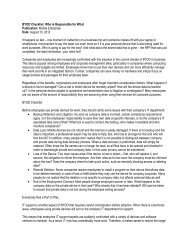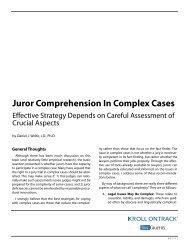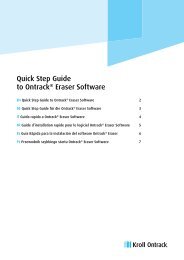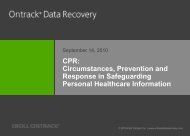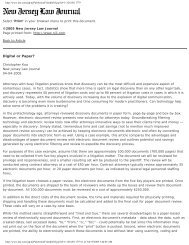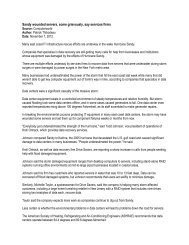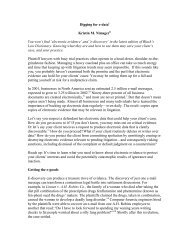Electronic Discovery and Computer Forensics Case List - Kroll Ontrack
Electronic Discovery and Computer Forensics Case List - Kroll Ontrack
Electronic Discovery and Computer Forensics Case List - Kroll Ontrack
Create successful ePaper yourself
Turn your PDF publications into a flip-book with our unique Google optimized e-Paper software.
the court observed the plaintiff’s other requests were broad enough to encompass the requested<br />
data, regardless of whether it was maintained in a "financial software database." The court<br />
determined the defendants need not produce documents specific to the plaintiff’s request but<br />
declared the defendants “may not withhold any documents (including electronic documents) that<br />
are responsive to any other request simply because they were created by or exist in a financial<br />
database program.” The court also denied the plaintiff’s expert direct access to the database<br />
indicating the plaintiff could seek direct access upon “a showing of why [direct access] is<br />
necessary, <strong>and</strong> by proposing a procedure containing adequate safeguards to protect [the<br />
defendants’] interests.”<br />
� Nova Measuring Instruments Ltd. v. Nanometrics, Inc., 417 F.Supp.2d 1121 (N.D. 2006). In a<br />
patent infringement case, the plaintiffs sought to compel production of documents in native format<br />
with original metadata. The plaintiffs asserted native production format was m<strong>and</strong>ated by a local<br />
patent rule that required a party defending a patent infringement claim to make available "[s]ource<br />
code, specifications, schematics, flow charts, artwork, formulas, or other documentation…” Finding<br />
the defendants failed to offer relevant reasons why the documents should not be produced in their<br />
native format, the court granted the motion <strong>and</strong> ordered the defendants to “produce the documents<br />
in their native file format, with original metadata.” The court further declared the document<br />
production set “shall be separately identified by Bates numbers to correspond to each aspect or<br />
element of each accused instrumentality identified in [the defendant’s patent] chart.”<br />
� Hynix Semiconductor, Inc. v. Rambus, Inc. v., No. C-00-20905 RMW (N.D.Cal. Jan. 4, 2006). In<br />
a patent infringement suit, the plaintiffs argued the defendant’s claims should be dismissed based<br />
on the defendant’s adoption of a document retention policy that resulted in the destruction of<br />
potentially relevant electronic <strong>and</strong> paper documents. Prior to filing the litigation at issue, the<br />
defendant developed a document retention policy requiring the destruction of e-mail contained on<br />
backup tapes after three months. In addition, the defendant held several “Shred Days” during<br />
which employees were instructed to follow the retention policy guidelines to determine what to<br />
keep <strong>and</strong> what to throw away. In assessing the plaintiffs’ argument, the court noted the evidence<br />
failed to show the defendant targeted any specific document or category of relevant documents<br />
with the intent to prevent production in the upcoming lawsuit. The court further found the<br />
defendant’s adoption of the policy was not designed to prevent the plaintiffs from obtaining<br />
evidence that would be helpful to the plaintiffs’ defense. For these reasons, the court declined to<br />
accept the plaintiffs’ argument <strong>and</strong> declared, “[The defendant’s] adoption <strong>and</strong> implementation of its<br />
content neutral Document Retention Policy in mid-1998 was a permissible business<br />
decision…[<strong>and</strong>] did not constitute unlawful spoliation.”<br />
� Sony <strong>Computer</strong> Entertainment Am., Inc. v. Filipiak, 2005 WL 3556676 (N.D.Cal. Dec. 27,<br />
2005). The plaintiff sought injunctive relief <strong>and</strong> damages claiming the defendant sold products that<br />
allowed users to play illegal copies of the plaintiff’s PlayStation video games. After receiving a<br />
cease-<strong>and</strong>-desist letter from the plaintiff’s attorneys, the defendant signed the letter <strong>and</strong> agreed to<br />
an injunction prohibiting the marketing, sale <strong>and</strong> distribution of the products. Although the<br />
defendant removed the products from his Web site, he continued to sell them. After confronting the<br />
defendant about his violation of the previous agreement, the parties executed a Consent Judgment<br />
against the defendant for an undetermined amount which was to be based on further discovery. As<br />
a part of the discovery provisions, the defendant agreed he would not destroy any documents or<br />
computer files reflecting sales of his products. During discovery, the defendant’s hard drive was<br />
examined by a computer forensic expert, who determined thous<strong>and</strong>s of files had been deleted from<br />
the hard drive just days before production of the hard drive. The deleted files included numerous<br />
242




